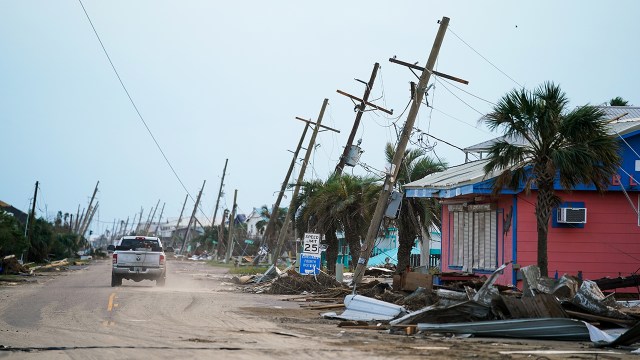
Two-thirds of Americans say extreme weather events across the country have been occurring more often than in the past. Far fewer say they’re happening about as often (28%), and only 4% say they are happening less often, according to a new Pew Research Center survey. The findings come amid reports that climate change has contributed to an increase in weather-related disasters.
Pew Research Center conducted this study to understand the public’s views of extreme weather and priorities for improving the country’s infrastructure. For this analysis, we surveyed 10,371 U.S. adults from Sept. 13 to 19, 2021. Everyone who took part in this survey is a member of the Center’s American Trends Panel (ATP), an online survey panel that is recruited through national, random sampling of residential addresses. This way nearly all U.S. adults have a chance of selection. The survey is weighted to be representative of the U.S. adult population by gender, race, ethnicity, partisan affiliation, education and other categories. Read more about the ATP’s methodology.
Here are the questions used for the report, along with responses, and its methodology.
See also: With extreme weather events and other disasters on the rise, how well are Americans prepared?
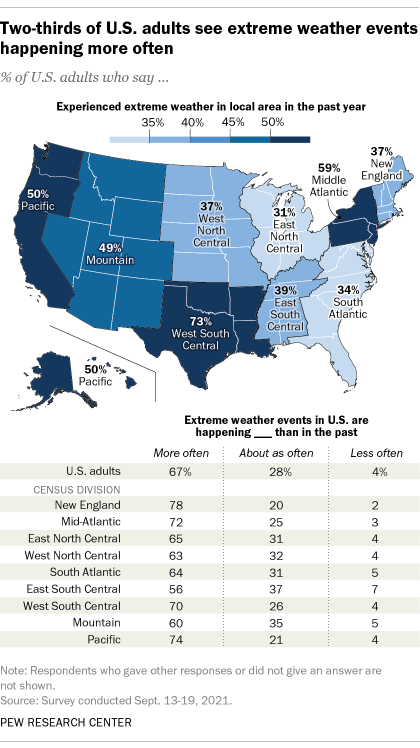
When it comes to firsthand experiences with extreme weather, 46% of U.S. adults say the area where they live has had an extreme weather event over the past 12 months, according to the survey, which was conducted Sept. 13 to 19 among 10,371 adults.
Global leaders are set to meet this fall at COP26, a United Nations conference on climate change, where attendees will discuss progress on cutting greenhouse gas emissions to limit global warming. Climate activists have argued that urgent action is needed as the world faces more frequent extreme weather events.
Nearly three-quarters of U.S. adults (73%) in the West South Central census division – an area hit hard by Tropical Storm Nicholas and Hurricane Ida – say they’ve experienced extreme weather within the past year. A majority of adults (59%) say the same in the Mid-Atlantic region, which was affected by recent heavy rains associated with Ida. By contrast, far fewer say they’ve experienced extreme weather in other regions over the past year, including in the South Atlantic (34%) and East North Central census divisions (31%).
In most census regional divisions, however, Democrats and Democratic-leaning independents are more likely than Republicans and Republican leaners to report experiencing extreme weather within the past year.
Overall, about half of Democrats (51%) say the area where they live has experienced extreme weather in the past year, compared with a smaller share of Republicans (39%).
A large majority of Democrats and Democratic-leaning independents (85%) say extreme weather events across the country have been occurring more often than in the past. Far fewer Republicans and GOP-leaning independents (44%) say the same; 52% of Republicans instead say such events are happening about as often as in the past.
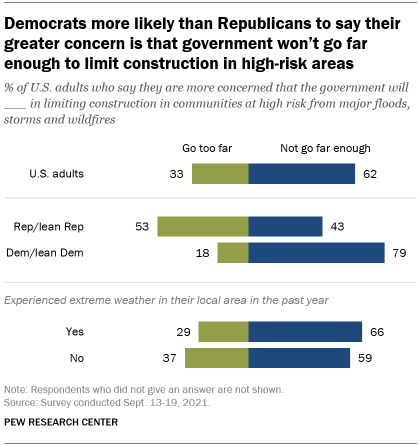
When asked to think about the government’s role when it comes to building in areas at high risk from major storms, floods and wildfires, 62% of U.S. adults say they are more concerned that government will not go far enough in limiting new construction. A smaller share (33%) say they are more concerned government will go too far in limiting new construction in high-risk areas.
A large majority of Democrats (79%) say their greater concern is that government will not go far enough in limiting construction in areas at high risk for extreme weather.
Views among Republicans tilt in the opposite direction: 53% say they are more concerned that government will go too far in limiting new construction in high-risk areas, while 43% say their greater concern is that government will not go far enough.
Those who say they have experienced extreme weather in their community recently are slightly more likely than those who have not to say their greater concern is that government will not go far enough to limit new construction in high-risk areas, though majorities in both groups take this view (66% and 59%, respectively).
How the public views key infrastructure goals
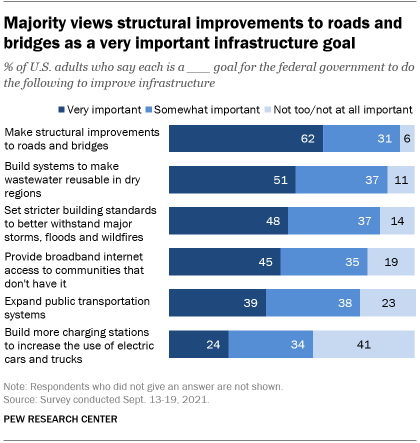
The survey also asked Americans about different aspects of the country’s infrastructure that the federal government could address. At the top of the list is making structural improvements to roads and bridges: Roughly six-in-ten adults (62%) say this is very important to them personally.
About half (51%) say it is very important for the federal government to build systems to make wastewater reusable in dry regions. Climate scientists expect that climate change will increase the severity of droughts in the future.
The survey also asked about the idea of stricter building standards to better withstand major storms, floods and wildfires – a strategy that could help reduce damaging effects from climate change. Around half of adults (48%) say setting stricter building standards is a very important goal to them, and 37% view this as a somewhat important goal.
Around four-in-ten or more Americans say it is very important to them for the federal government to provide broadband internet access to communities that don’t have it (45%) and to expand public transportation systems (39%).
Only 24% of adults say it is very important for the federal government to build more charging stations to increase the use of electric vehicles receives – the lowest level of public importance for any of the six items in the survey. Around four-in-ten adults (41%) say this is not important, while about a third (34%) say it is somewhat important to them. In an earlier Center survey, just 7% of U.S. adults said they currently own an electric or hybrid vehicle.
Overall, 51% of the public favors the infrastructure bill now being debated in Congress, compared with a smaller share (20%) who oppose it; 29% say they aren’t sure how they feel about it.
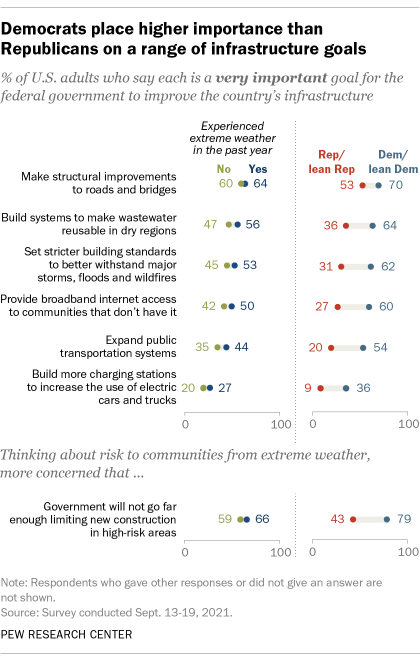
Partisanship matters far more than other factors – including where people live – when it comes to Americans’ views about the country’s infrastructure and the government’s role in adaptation to risks from extreme weather.
For instance, 62% of Democrats say it’s a very important goal for the federal government to set stricter standards to better withstand major storms, floods and wildfires. Half as many Republicans (31%) say that is very important to them personally.
There are generally modest differences in views between those who say they have experienced extreme weather locally in the past year and those who say they have not.
Note: Here are the questions used for the report, along with responses, and its methodology.

